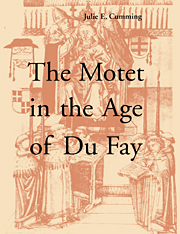Book contents
- Frontmatter
- Contents
- List of tables
- List of musical examples
- Acknowledgments
- Notes to the reader
- Introduction
- Part I Models and methods
- Part II Motets in the early fifteenth century: the case of Bologna Q15
- 4 The motet section of Bologna Q15 and its ramifying roots
- 5 A new hybrid subgenre: the cut-circle motet
- 6 Other new hybrid subgenres
- 7 The motet in the early fifteenth century: evolution and interpretation
- Part III Motets in the mid-fifteenth century: the case of the Trent Codices
- Conclusion
- Appendix: Widely disseminated motets
- Notes
- Bibliography of books and articles
- Modern editions of music
- Sources and sigla
- Notes on the index of works
- Abbreviations for subgenre identifications
- Index of works
- General index
5 - A new hybrid subgenre: the cut-circle motet
Published online by Cambridge University Press: 22 September 2009
- Frontmatter
- Contents
- List of tables
- List of musical examples
- Acknowledgments
- Notes to the reader
- Introduction
- Part I Models and methods
- Part II Motets in the early fifteenth century: the case of Bologna Q15
- 4 The motet section of Bologna Q15 and its ramifying roots
- 5 A new hybrid subgenre: the cut-circle motet
- 6 Other new hybrid subgenres
- 7 The motet in the early fifteenth century: evolution and interpretation
- Part III Motets in the mid-fifteenth century: the case of the Trent Codices
- Conclusion
- Appendix: Widely disseminated motets
- Notes
- Bibliography of books and articles
- Modern editions of music
- Sources and sigla
- Notes on the index of works
- Abbreviations for subgenre identifications
- Index of works
- General index
Summary
Many of the motets in Bologna Q15 (especially motets by northern composers working in Italy) are recognizably different from earlier local traditions. I call these new varieties of motet “new hybrid subgenres” – hybrids of the various older local traditions. Some of these new hybrid subgenres retain the texture of the medieval motet; others adopt the English cantilena texture. Although composers drew on their experience of other treble-dominated genres (such as the French chanson, the Italian lauda, or the Mass Ordinary movement), I believe that it was the popularity of the English cantilena and its absorption into the continental motet that spurred continental composers to embrace so enthusiastically the new texture for the motet. The result was an abundance of wonderful new music, as we shall see.
Most of the non-English cantilena-style motets in Bologna Q15 can be grouped into a subgenre that I call the “cut-circle motet” because of its use of a rhythmic style associated with the mensuration known as cut-circle (Ø) or tempus perfectum diminutum, although they do not all use this mensuration sign (see Table 5.1, pp. 110–11). Many of the cut-circle motets are also characterized by other features, such as melodic figures, florid melismas, fermata sections, and repeated-note figures in imitation. None of these features can be associated with every one of the cut-circle motets, making this a good case of a family resemblance category, in which the members are related in a variety of ways, and features occur in various combinations.
- Type
- Chapter
- Information
- The Motet in the Age of Du Fay , pp. 99 - 124Publisher: Cambridge University PressPrint publication year: 1999
- 1
- Cited by



